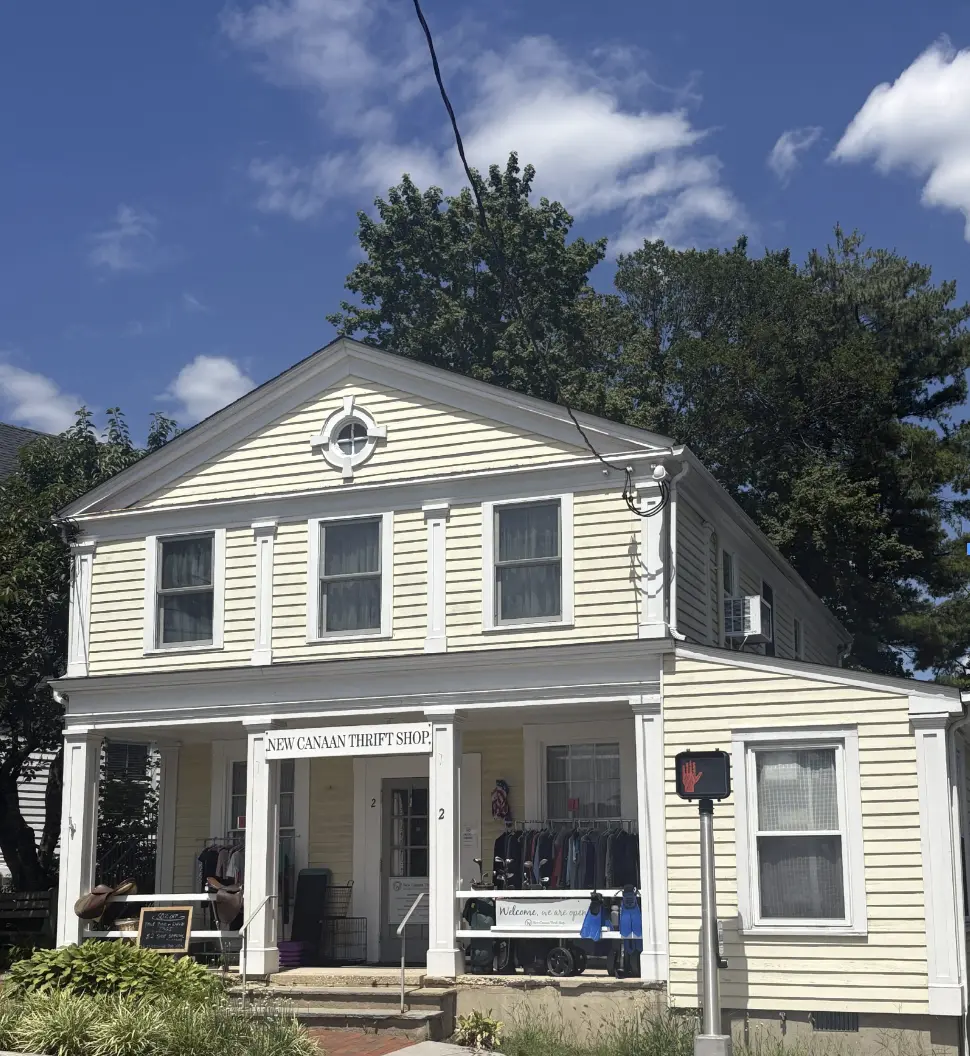
By Geri Rhoades
Strolling down Main and Elm, there is no shortage of fantastic shopping opportunities. Our walkable downtown area is filled with interesting, locally owned shops, as well as some well-known chain stores. We also boast one of the oldest volunteer-run thrift shops in the country, offering fabulous finds for those willing to take the time to browse.
I hadn’t been back to a traditional non-profit thrift shop since college, when we would all take a trip to Sals Boutique, better known as the Salvation Army. I had heard that our thrift shop was special, so I decided to check it out myself.
Visiting the New Canaan Thrift Shop is an experience that begins the moment you approach the door. The beautiful building, constructed by Joseph Schofield in 1840, has served various purposes over the years, including as a morgue, furniture warehouse, and hair salon, before being sold to the Visiting Nurses in 1953. It was later acquired by the non-profit Waveny Lifecare Networks, which provides comprehensive care, primarily to seniors. In recognition of their stewardship of the historic property, Waveny received the New Canaan Preservation Alliance President’s Award in 2022 for the continued care and preservation of the building.
After passing the leather saddles on the front porch, I entered the shop. The first room was bustling with shoppers. This area showcases household items, china, and jewelry, arranged to resemble a well-designed shop. I stopped to browse and found a lovely teapot, which I was tempted to purchase.
A couple of steps down, I discovered racks of women’s clothing, some purses and shoes, plus a small nook at the back with additional home goods. I spotted eight Country Living Red Friends Rooster Plates, usually priced at $19 each on replacements.com, marked at just $28 for all eight. Despite the temptation, I resisted buying them as I’m currently in a Marie Kondo phase; it took quite a bit of willpower since they were adorable.
Continuing my exploration, I descended to the sporting goods section, which included linens, luggage, skis, tennis rackets, and snowboards. Heading back upstairs, I found the men’s area along with sections for boys and teens. On my way to the designated area for infants and girls, I encountered shelves filled with children’s books, CDs, and DVDs—items that seem to be making a comeback.
I did, however, make one purchase. Throughout the building, art pieces hang on the walls. You need to know a bit about art—or at least have your smartphone handy—to find a gem. I bought a signed George Englert painting for just $6, whereas I found unsigned ones selling for hundreds on eBay.
I also had the chance to chat with a few of the 12-15 volunteers who work in shifts throughout the week. Lynn Singalies, a shopper-turned-volunteer, has been part of the program for 30 years, while Ann Read has been involved for 15 years. Their long-term commitment impressed me. According to Richard Sgaglio, Executive Director of Marketing, “Their commitment and community spirit make the shop the special place it is.”
I was surprised to learn about the significant contribution the thrift shop makes to Waveny Care. Richard mentioned that the Thrift Shop raises approximately $240,000 each year. “Every dollar goes directly toward supporting unfunded patient care, ensuring that those in our community receive high-quality healthcare services regardless of their ability to pay. It’s a powerful example of how small donations and purchases can make a big impact,” Richard shared.
In the traditional sense, thrifting dates back to the early 19th century, when organizations began collecting and selling items to fund their charitable causes. The earliest US shop on record is the Salvation Army, which was organized in 1899 to help the massive influx of impoverished immigrants. However, the concept can be traced even further back to ancient times, when exchanging goods was a common practice.
In the late 19th and early 20th centuries, the thrift movement gained momentum, emphasizing the values of saving money, being frugal, and repurposing items. This aligned with the economic challenges of the time, including the Great Depression, when people began donating items to charitable organizations, leading to the creation of the first thrift stores.
The 1960s and 1970s witnessed a surge in the popularity of vintage fashion, unique finds, and sustainability. This movement continued to grow in the 1980s and 1990s. Today, thrifting can also be found online, with platforms like ThredUp and Poshmark offering a convenient alternative.
The New Canaan Thrift Shop accepts donations of gently used articles of clothing, accessories, jewelry, books, sporting goods, small appliances, housewares, china, silver, paintings, crockery, toys, games, and small home furnishings. Please be sure your donations are boxed or bagged.
The New Canaan Thrift Shop is open from 11:00 am to 4:00 pm, Monday through Friday, and from 9:00 am to 1:00 pm on Saturday. Donations are accepted from 9:00 am to 12:00 noon, Monday through Friday.
According to Richard, “The Thrift Shop continues to thrive because it’s a place where compassion and community intersect.”
Geri Rhoades, PhD, is a New Canaan resident and Board Member of the New Canaan Beautification League. Since retiring from the field of Communications, Geri has concentrated on helping to make the world a better place.

